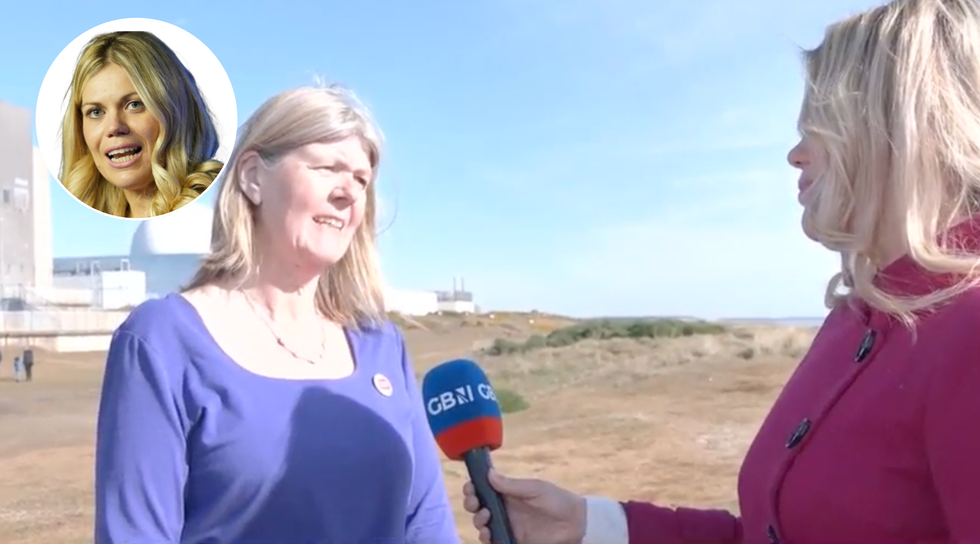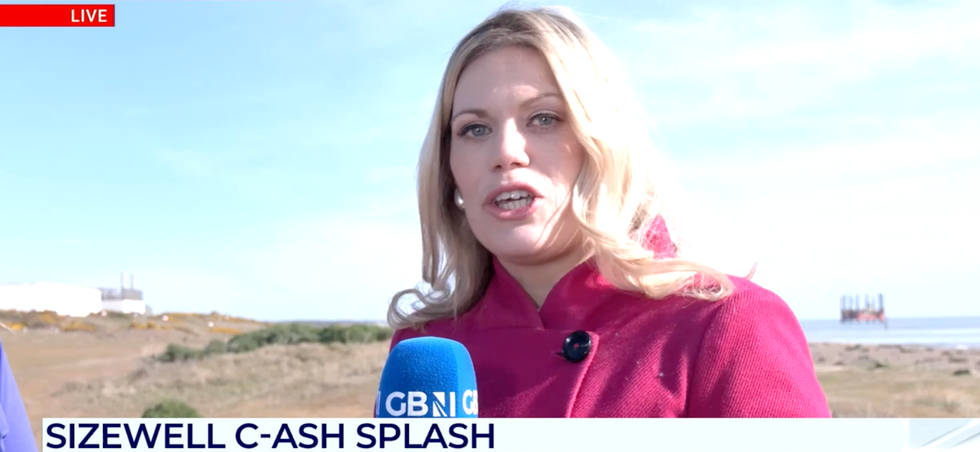Haunted by HS2, we cannot afford to ignore the opposition to Britain's latest white elephant - Miriam Cates
OPINION: Nuclear power has real potential, but that doesn’t mean every nuclear project is worth pursuing
Don't Miss
Most Read
Trending on GB News
Both this Government and the last have hailed the planned Sizewell C nuclear power station in East Suffolk as a cornerstone of the UK’s energy future. But after visiting the site last week, I am now firmly convinced that we cannot afford to ignore the rising tide of opposition. With costs spiralling out of control and doubts over the design of the reactor, campaigners say Sizewell C is fast becoming another British infrastructure white elephant.
Britain’s need for secure, reliable, and affordable energy has never been more acute. In recent years, domestic energy bills have soared, with the average household paying around £1800 annually. Since the 1990s, successive governments have turned toward renewable energy, and today over 50 per cent of the UK’s electricity comes from clean sources like wind and solar. In fact, over the Easter weekend last year, renewables met Britain’s entire energy demand for a record four-day period.But despite this progress, household bills remain stubbornly high.
A key reason is that renewables, by their nature, are intermittent. Though wind and solar are ‘free’ at source, they cannot always be relied upon — the wind doesn’t always blow, and the sun doesn’t always shine. To ensure continuity of supply, backup power supplies must always be available. That means the full cost of renewable energy must include the infrastructure required to support it when nature doesn’t cooperate.
Currently, the UK relies on two main forms of backup: natural gas and nuclear power. Gas, while reliable and relatively quick to deploy, is a fossil fuel that emits carbon dioxide and leaves the UK vulnerable to geopolitical volatility, as we have seen in the aftermath of Russia’s invasion of Ukraine. The UK no longer produces enough gas to be self-sufficient, and prices are subject to international markets.
That leaves nuclear power, a source that has been part of the British energy mix since the mid-20th century. While controversial — especially among some factions of the political Left — nuclear power is generally recognised today as a clean, safe, and stable energy source. But it comes with significant challenges: nuclear plants are eye-wateringly expensive, take years to construct, and have a finite lifespan.
Waste is difficult—and dangerous—to dispose of. Long-term planning is therefore essential to ensure continuity as older plants are retired. To this end, in 2008, the then Labour government decided to commission a new fleet of nuclear power stations to replace Britain’s ageing reactors. In 2010, it was announced that eight sites were under consideration, and in 2015, this was narrowed down to three projects: Hinkley Point C, Sizewell C, and Bradwell B. All have since faced severe delays, funding disputes, and environmental pushback.

Haunted by HS2, we cannot afford to ignore the opposition to Britain's latest white elephant - Miriam Cates
GB News
Perhaps most concerning is the potentially unreliable French-designed reactor selected for the Sizewell and Hinkley projects. Even EDF, the French state-owned company responsible for their construction, has admitted they won’t use this design again in France.
Hinkley Point C, after years of setbacks, finally began construction in 2017. It is now estimated that it will cost up to £46 billion (in 2024 money) and is at least five years behind schedule, with completion of reactor 1 expected between 2029 and 2031. Unsurprisingly, this experience has done little to reassure locals in Sizewell. East Suffolk is no stranger to nuclear energy.
Sizewell A began operating in 1966 and generated electricity until 2006. Sizewell B — with its iconic “golf ball” dome — was commissioned in 1995 and remains the UK’s only commercial pressurised water-cooled reactor power station. But Sizewell C would dwarf both its predecessors. And locals fear the disruption, environmental damage, and economic consequences could all be for nothing.
When I visited, I spoke to farmers whose land had been acquired under threat of compulsory purchase, rendering their businesses barely viable. David Boden, who has lost twenty per cent of his farm, described the landscape as more like an open-cast mine than East Anglian farmland. Ancient woodland has been cut down. Shops and pubs, such as Tom Lagden’s Theberton Lion, once thrived from tourist footfall, yet are now struggling thanks to diverted traffic and road closures.
The claim that Sizewell C will bring economic benefits is hotly disputed. William Kendall, a local businessman, pointed out that the influx of contractors working on the project has pushed housing prices sky-high, and hospitality businesses that cannot compete with Sizewell C wages now struggle to attract workers.

The claim that Sizewell C will bring economic benefits is hotly disputed, writes Miriam Cates
GB
It’s tempting to dismiss such resistance as NIMBYism. But concerns go far deeper than local inconvenience. Many residents — and even energy experts — doubt the project’s viability altogether. The most pressing concern is cost. Sizewell C has already soaked up more than £6billion in public money, despite not yet having received final approval for its go-ahead.
Due to security concerns, the UK Government rightly bought out Sizewell C’s Chinese investor, but this leaves the British taxpayer dangerously exposed. If completed, Sizewell C could cost upwards of £40billion, meaning the price of electricity generated would be some of the most expensive in history. And if it is not completed, the money wasted on Sizewell C would be a disastrous loss for the UK taxpayer in what is an already challenging economic climate. There are significant engineering hurdles ahead. While Hinkley Point C is considered a “dry” site, Sizewell C will sit just a few hundred metres from a coastline that is eroding.
Rising sea levels pose serious design and safety challenges. Yet nearly two decades after it was first proposed, the project is still awaiting final agreement. Sadly, this has become something of a national pattern. Britain seems increasingly incapable of delivering infrastructure projects on time or budget. HS2 has become the poster child for this dysfunction, with billions spent and huge swathes of the project scrapped. The proposed Lower Thames Crossing has already cost taxpayers £1.2billion before a single spade has broken ground. Sizewell C risks becoming the next chapter in this sorry tale of undelivered promises.
One of the biggest red flags in the Sizewell C project is the apparent lack of private investors Unlike any previous nuclear project in the UK, Sizewell C will use a Regulated Asset Base (RAB) funding model, meaning consumers will start paying for the plant through higher energy bills long before it generates a single watt of electricity.
If the project is later abandoned, those billions will have vanished, with nothing to show for it. As Alison Downes from the campaign group ‘Stop Sizewell C’ explained, this is a dangerous gamble. With no private capital at risk, there is less pressure to deliver efficiently, and fewer safeguards against spiralling costs. If the government eventually admits the project cannot deliver power in time to meet the UK’s needs, taxpayers will be left footing the bill for a plant that never powered a single home.
This is the fundamental issue. Nuclear power remains a powerful technology with real potential. But that doesn’t mean every nuclear project is worth pursuing. The scale, cost, and complexity of Sizewell C make it a high-risk, high-cost endeavour in a world that may soon have better options.
As Small Modular Reactors show increasing potential to become the future of nuclear power, and as battery storage capacity for renewables becomes more viable, the case for long, costly, inflexible nuclear builds begins to weaken. It’s always politically difficult to cancel a flagship project. The temptation is to press on, regardless of mounting costs or delays, for fear of admitting failure. Unlike in the business world, where profit and shareholder considerations compel firms to ditch loss-making failures, in politics, it’s often much easier to kick the can down the road and let the next administration decide.
But pouring more money into a flawed project is utter folly; government ministers must have the bravery to look again at the viability of Sizewell C. If we want to keep the lights on, and do it affordably, it’s time to ask the hard question: should we cut our losses before it's too late?








